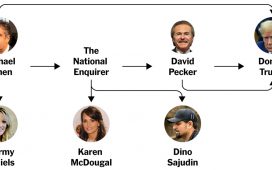And one asset outperforming them all was Bitcoin. The highly volatile, and much maligned, cryptocurrency rose about 180 percent so far this year, even rising to as much as $14,000 this past week. (At the time of writing, it’s back below $12,000.)
But the climb to record stock highs was not entirely smooth. President Trump’s escalation of his trade war with China sent stocks tumbling in May. As Howard Silverblatt, a senior index analyst for S&P Dow Jones Indices, pointed out:
“April was up 3.93 percent, closing at a new high (2945.83), May was down 6.58 percent (2752.06), closing two-thirds of the way to a correction, and June was up 6.89 percent (2941.76), as it posted the best June since 1955.”
And other markets have flashed warning signs about geopolitical tensions and economic growth that suggest problems may still be on the horizon.
• Yields on government bonds have been falling fast — everywhere. Australia, Britain, Germany Japan and the U.S. have all experienced it, and the value of negative yielding bonds around the world hit $13 trillion in the past week.
• The yield on the 10-year Treasury note — usually considered to be an incredibly risk-free investment — plunged below 2 percent several times this year, for the first time since President Trump was elected.
• In fact, the U.S. government bond that’s due in three months will currently pay a higher yield than a government bond that is due in 10 years — a phenomenon known as an “inversion.” Such occurrences are rare, but they have preceded every recession over the last 60 years (although some of those downturns took up to two years to materialize).
• Oil prices earlier in June had tumbled more than 20 percent since late April because of growing fears that demand would be weaker than expected as the global economy slows.
What now?
Here’s what some of Wall Street’s experts have to say about the next six months of 2019:
Rising political uncertainties “still seem to be the main economic risk,” write strategists at the Wells Fargo Investment Institute. “Fortunately, fiscal and monetary policymakers in the U.S., Europe, and China have added stimulus measures, and more global central banks are likely to cut interest rates. A U.S.-China trade agreement could help restore positive global trade growth and may particularly benefit Europe and Japan.”






